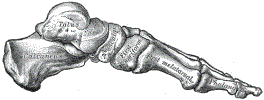Subtalar Dislocation, Dislocation of Subtalar Joint
- See Also
- Epidemiology
- Rare foot dislocation
- Subtalar Dislocations represent only 1 to 2% of all dislocations
- Young men account for a majority of cases
- Pathophysiology
- High energy injury (e.g. Motor Vehicle Accident, fall from height, sports such as basketball)
- Perform a full Trauma Exam on all patients
- Disruption of two joints (breaking through joint capsules and strong ligaments)
 Lewis (1918) Gray's Anatomy 20th ed (in public domain at Yahoo or BartleBy)
Lewis (1918) Gray's Anatomy 20th ed (in public domain at Yahoo or BartleBy)- Talocalcaneal joint
- Talonavicular joint
- Dislocation Direction Based on Midfoot Displacement
- Medial Subtalar Dislocation (65 to 85% of cases)
- High force inversion injury while foot is plantar flexed
- Lateral Subtalar Dislocation (15 to 35% of cases)
- High force eversion injury while foot is plantar flexed
- Higher complication rate (e.g. open dislocation, interposed tissue preventing closed reduction)
- Anterior Subtalar Dislocation (rare)
- Posterior Subtalar Dislocation (rare)
- Medial Subtalar Dislocation (65 to 85% of cases)
- Signs
- Imaging
- XRay Foot
- Obtain pre-reduction and post-reduction films
- CT Foot
- Evaluate for occult associated injuries
- Associated occult injuries are common and frequently change management (e.g. ORIF)
- Fifth Metatarsal Fracture
- Talus Fracture
- Malleolus Fracture
- Osteochondral Fracture
- References
- Management
- Closed Reduction
- Perform emergently under Procedural Sedation
- Patient supine with knee flexed to 90 degrees (relaxes calf Muscles)
- Apply inline traction and countertraction
- Accentuate the deformity, and then reverse to reposition
- Apply direct pressure to talar head
- Interposed tissue may not allow for reduction (esp. lateral dislocations)
- Open reduction may be needed (one third of cases)
- Immobilization (4 to 6 weeks is typical)
- Referral
- Consult Orthopedics or podiatry for follow-up
- Emergent Consultation indications
- Open Fracture
- Neurovascular compromise
- Non-reducible dislocation
- Complications
- Open dislocation (25% of cases, esp. lateral dislocation)
- Post-Traumatic Arthritis (50-80% of cases)
- Reduced subtalar range of motion (80% of cases)
- Talus necrosis
- Subtalar Joint Stiffness
- References
- Jong and Huang (2022) Crit Dec Emerg Med 36(4): 22-3
- Lakey and Storch (2023) Crit Dec Emerg Med 37(2): 18-9
- Lugani (2022) Musculoskelet Surg 106(4):337-44 +PMID: 35435636 [PubMed]
- Prada-Cañizares (2016) Int Orthop 40(5):999-1007 +PMID: 26208589 [PubMed]